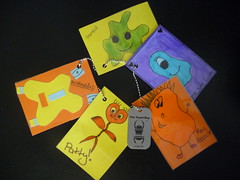Wednesday, April 29, 2009
Do You Create Dolphin Bubbles?
Surely you create dolphin bubbles!
You're a creative person who is reading this because you love to learn, and you thrive on creating rich learning experiences for yourself and for others.
I came across this video courtesy of a tweet by Joe Evans. It reminds me that in creating original content, we do so as members of a community. Once created, do we keep our original content to ourselves, or do we celebrate, share, and honour our work by giving it away?
I'll think of my work on innovative projects as 'dolphin bubbles' for the next little while, and will do my best to be more generous than these captive dolphins are with their creations. While they are inventive with limited means, and are great at learning from one another, these dolphins can still learn a few things about sharing and Creative Commons!
Pssst! Please don't tell the dolphins that their actions have been videotaped, or the we may find ourselves in a situation...
See Larry Lessig's recent tweet!
Labels:
bubbles,
community,
creative commons,
creativity,
dolphin,
sharing
Tuesday, April 28, 2009
Monsters come to Komoka
Remember the days when you used to follow treasure maps to find buried treasure? If you led a less exciting life as a child, you'll be happy to know that you and your students can both find treasure, and hide it through Geocaching.
Although I'd known about Geocaching for some time, it took an invitation from Jarrod Robinson for me to undertake a first hand exploration of this growing phenomenon. An overview of the Australian origins of this project is included in this brief audio podcast:
At the launch of the project, Mr. Robbo: The P.E. Geek, posted this video introduction to the monsters project:
On Saturday, we went treasure hunting!
 Step 1: The monsters arrived via air mail from Australia. We unpacked the envelope and discovered a number of hand-drawn monsters, attached to a Travel Bug.
Step 1: The monsters arrived via air mail from Australia. We unpacked the envelope and discovered a number of hand-drawn monsters, attached to a Travel Bug.
Step 2: After recording the tracking number of the Travel Bug, we documented the arrival of the attached monsters at Geocaching.com.
 Step 3: We chose an existing cache at the Komoka Railway Museum, as the first hiding place for the monsters.
Step 3: We chose an existing cache at the Komoka Railway Museum, as the first hiding place for the monsters.
As much as it was fun to play hide & seek via geocaching, we discovered a number of additional, unanticipated treasures:
making treasure maps;
climbing on rail cars;
hearing stock car races echo in the valley;
hiking around the Kilworth pond,
confirming that beavers live in the neighbourhood.
We had a gorgeous day to explore, but I suspect this recreational hobby can be enjoyed year-round. If you're interested to learn what may be hiding in your neighbourhood, simply input your postal/zip code at Geocaching website, then take the next step, and seek out the hidden treasure!
For more photos of our hike, visit my Geocaching photos via Flickr.
Although I'd known about Geocaching for some time, it took an invitation from Jarrod Robinson for me to undertake a first hand exploration of this growing phenomenon. An overview of the Australian origins of this project is included in this brief audio podcast:
At the launch of the project, Mr. Robbo: The P.E. Geek, posted this video introduction to the monsters project:
On Saturday, we went treasure hunting!
 Step 1: The monsters arrived via air mail from Australia. We unpacked the envelope and discovered a number of hand-drawn monsters, attached to a Travel Bug.
Step 1: The monsters arrived via air mail from Australia. We unpacked the envelope and discovered a number of hand-drawn monsters, attached to a Travel Bug.Step 2: After recording the tracking number of the Travel Bug, we documented the arrival of the attached monsters at Geocaching.com.
 Step 3: We chose an existing cache at the Komoka Railway Museum, as the first hiding place for the monsters.
Step 3: We chose an existing cache at the Komoka Railway Museum, as the first hiding place for the monsters.As much as it was fun to play hide & seek via geocaching, we discovered a number of additional, unanticipated treasures:
making treasure maps;
climbing on rail cars;
hearing stock car races echo in the valley;
hiking around the Kilworth pond,
confirming that beavers live in the neighbourhood.
We had a gorgeous day to explore, but I suspect this recreational hobby can be enjoyed year-round. If you're interested to learn what may be hiding in your neighbourhood, simply input your postal/zip code at Geocaching website, then take the next step, and seek out the hidden treasure!
For more photos of our hike, visit my Geocaching photos via Flickr.
Labels:
australia,
geocaching,
jarrod robinson,
komoka,
monsters,
travel bug
Thursday, April 23, 2009
Top Ten Benefits of Handhelds in the Classroom

One-to-One computing is already here, it's just that we can't experience it on a large scale, until we accept the validity of cell phone technology in the classroom. Here are just a few examples of the potential of this micro-computer technology, should we allow students to bring wifi enabled mobile communicators to school:
1] Photography: Students will leverage cell phone cameras to document science experiments; to create photo essays; to archive learning experiences...
2] Cloud Apps: Wifi enabled cell phones will provide access to instant news; collaborative wikis; and a wide variety of other web-based documents. What's more, access to documents will allow both reading & writing.
3] Synchronous Audio: Whether linking with classmates; or connecting with relevant real world experts, the potential for free communication via Skype and other wifi services will further erode classroom walls.
4] File-sharing: Savvy teachers will engage personal computers as Bluetooth servers to automate the delivery of text, audio, and mixed media content to student hand-helds. For examples of the potential for this technology, visit Jarrod Robinson's blog.
5] Geotagging: As global positioning technology (GPS), becomes common on mobile phones, it will be used to post text, audio and photo content with automatic tags to geographic locations. Partnered with Quick Response codes (QR tags) the resulting cloud content can be drawn to hand-helds through the snapping of photos.
6] Podcasting: Recent studies are demonstrating the value of recordings to student learners who are growing up in a world of random access. With the potential for retrieving content produced by both students and teachers, the use of portable audio as a universal design for learning, is long overdue.
7] Streaming: Besides allowing handhelds to view streaming content, apps on the iPhone and other modern mobile phones, now allow live audio and video broadcasting. Classroom channels will soon share learning with parents and other interested community members.
8] Tweet-notes: Two-way Twitter feeds now available via mobile clients, can connect students to students; classrooms to classrooms; teachers to teachers. Realizing that text message conversations provide opportunities to save, share and search ideas, we may soon be using Twitter Search as often as we use Google.
9] Learning Through Gaming: Video game producers have been slow to meet educational needs with their hand-held devices, but Flash-based learning activities are becoming ubiquitous on the wider web. As mobile browsers evolve to represent this content, every classroom will have open access to engaging learning apps.
10] The World at Hand: The day's global news; electronic libraries; and user-generated content will be available to each student. With the sum of all human knowledge in the palm of the hand, educators will be forced to address issues of validity and bias, and will have to re-think how students can demonstrate their learning. I for one, await the advent of the open phone test!
What other educational changes can we expect, once we welcome mobile phones in the regular classroom?
Photo Credit: Jason Jerde
Labels:
1:1,
audio,
bluetooth,
broadcasting,
cell phone,
mobile,
video,
wifi
Tuesday, April 21, 2009
What Else is Broken?
Seth Godin recently reposted "This is Broken", a talk from a few years ago, that has me wondering why we don't do more about fixing an education system that so many of us realize is broken...
What's broken in school?
Why do high schools begin classes before teens are awake?
Why do we rely on written tests for students to demonstrate their learning?
Why do students have to sit in such uncomfortable chairs?
Why do we prevent useful technologies like cell phones from entering the classroom?
Why do 5 year olds have to carry backpacks to school?
Why does chalk still exist in classrooms?
Why does so much 'learning' take place with students sitting down and listening?
Why do the best teachers often feel like they have to teach with their doors closed?
What broken things would you like to add to the list?
How can we being to fix some of these broken things?
What's broken in school?
Why do high schools begin classes before teens are awake?
Why do we rely on written tests for students to demonstrate their learning?
Why do students have to sit in such uncomfortable chairs?
Why do we prevent useful technologies like cell phones from entering the classroom?
Why do 5 year olds have to carry backpacks to school?
Why does chalk still exist in classrooms?
Why does so much 'learning' take place with students sitting down and listening?
Why do the best teachers often feel like they have to teach with their doors closed?
What broken things would you like to add to the list?
How can we being to fix some of these broken things?
Labels:
broken,
classroom,
repair,
school,
seth godin
Wednesday, April 15, 2009
Educhat Revisited
We've had a number of runs at Educhat over the past few months, and a recent email has me thinking out loud about how we might use this bi-weekly meeting to facilitate meetings along the model of professional learning communities.
If you'd like a reminder about how Educhat was originally envisioned, check out this earlier post.
If you'd like a reminder about how Educhat was originally envisioned, check out this earlier post.
Monday, April 13, 2009
Welcome to Learning Street
 In recent years, I've been left to wonder, where the learners are... not among students, but among my professional colleagues.
In recent years, I've been left to wonder, where the learners are... not among students, but among my professional colleagues.Leadership is best modeled when we support others in way-finding, experimentation, and risk-taking. If educators expect their charges to take risks in extending their learning with the support of teachers, then each of us, should at times explore new instructional practices with the guidance of supportive colleagues.
Working in what Vygotsky called the zone of proximal development, is best accomplished with colleagues who, through varied interests and experiences, can offer unique supports to co-learners. In an environment that supports collaborative exploration and open sharing, it won't take long for teacher-learners to act as mentors for other colleagues.
 Educators often look for leaders to mentor their own personal & professional growth; but if it is true that the corner office is where creative ideas go to die, then you might be better off looking to your peers to fulfill your personal learning needs. Fortunately, the educational blogosphere is filled with many knowledgeable colleagues, each of whom is ready to nurture fellow learners.
Educators often look for leaders to mentor their own personal & professional growth; but if it is true that the corner office is where creative ideas go to die, then you might be better off looking to your peers to fulfill your personal learning needs. Fortunately, the educational blogosphere is filled with many knowledgeable colleagues, each of whom is ready to nurture fellow learners. Photo Credit: Brian Lewandowski & Michael Toy
Labels:
leadership,
mentorship,
pd,
professional learning,
risk taking
Thursday, April 9, 2009
The World Wide Web in Plain English
I know a number of adults (let alone students) who will appreciate this short, simple explanation of how the Internet works... courtesy of Common Craft.
Passing Notes on the Back-Channel

Would you ever consider allowing students to pass notes during class?
If you've attended a conference, either in person or virtually, where backchannels have been harnessed, you'll understand why this might be worth considering.
Professor Encourages Students to Pass Notes
Slidecasting 2.0
Photo Credit: William K.
Labels:
back-channel,
chat,
classroom,
engagement,
twitter
Tuesday, April 7, 2009
Did We Miss the Arrival of Web 3.0?

"I am he as you are he as you are me and we are all together."
From I Am the Walrus by the Beatles
Web 3.0: Live, Free, and Interactive
I'm of the growing opinion, that when the read-write web is harnessed for live broadcasts, it's symptomatic of Web 3.0. When these broadcasts are produced by amateurs, at low or no cost, and when remote participants can join in from practically anywhere on the globe, I'm convinced that the World Wide Web has made the leap!
Perhaps it all began most fervently with the recent inauguration of U.S. President Barack Obama, which was simulcast live, on television, radio, and the Internet. At the same time, witnesses to this event were sharing their experiences in text, photography, audio and video... and the traditional media was inviting our participation!
As I write this, I'm watching the live launch of a new Twitter client:Seesmic Desktop, and even though the product may fizzle, the fact that any developer can broadcast live to the Web at a moment's notice, should make us sit up and take notice.
Other well known online entities are also joining in. A few weeks ago, the TED Prize was broadcast live on a crystal clear stream, via the web.
My brother Todd, recently returned from the G20 Summit where he reported in audio, video and text, the goings on as they happened, along with 49 other global bloggers.
Educators like Alec Couros, regularly broadcast live conference and classroom presentations to UStream, and where last year, such a broadcast would have required a camera-equipped computer and a robust wifi connection; today these broadcasts can happen via a well equipped mobile phone with apps like UStream and Qik.
 Another of my brothers, Tom, regularly broadcasts the work of independent musicians and is experimenting with feeding other events live from his bar, Phog Lounge, in Windsor, Ontario.
Another of my brothers, Tom, regularly broadcasts the work of independent musicians and is experimenting with feeding other events live from his bar, Phog Lounge, in Windsor, Ontario.The exploding popularity of Twitter, and the judicious use of hashtags, is leading to the live broadcast of sports; the instant reporting of environmental disasters; and as-it-happens documentation of courtroom dramas.
No matter where you may be, or what you might be experiencing, the interwoven mesh of digital networks is making it possible for your time and space to be shared with a global audience... and what's more, these events invite our remote participation on back-channels!
To paraphrase Dorothy in the Wizard of Oz "Toto, I don't think we're in Web 2.0 any more!"
Photo Credit: G20 Voice; Aaron Booth
Sunday, April 5, 2009
Customer Service Tweets
 More and more, Twitter is being leveraged by marketers. If you haven't yet been contacted based on a tweet you've sent, it's only a matter of time! This podcast includes snippets of an interview I recently had with Devin Hughes, a member of the marketing team at Wetpaint, who contacted me based on Twitter chatter regarding our e-book project at Twitter for Teachers.
More and more, Twitter is being leveraged by marketers. If you haven't yet been contacted based on a tweet you've sent, it's only a matter of time! This podcast includes snippets of an interview I recently had with Devin Hughes, a member of the marketing team at Wetpaint, who contacted me based on Twitter chatter regarding our e-book project at Twitter for Teachers.Related Sites:
Fresh Coats where Devin Hughes' tells Wetpaint stories
Wetpaint
Wetpaint Central
Wikis in Education
G20 Voice
Climate Cafe where Todd Lucier uses his G20 voice
Friday, April 3, 2009
Stories of Co-Design
Students and teachers alike, can learn plenty from the way today's technology leaders work collaboratively in designing solutions to our communications problems.
If you're like me, you've likely discovered that initiatives undertaken with peer support, that are developed with the cooperation of supervisory staff, tend to be the most successful. Similar ideas, pursued by lone individuals, struggle in contention for attention and funding.
In The Story of Co-Design, the potential of collaborative problem solving is engaged in order to meet the needs of the inhabitants of Panda Island. The metaphor can work for identifying the needs of a school community, a provincial ministry of education, or a network of users on the World Wide Web.
The Story of Co-Design from thinkpublic on Vimeo.
If you think you have a great idea, take heed of today's technology leaders, and engage others in collaborative planning & development:
1] Facebook Connect is allowing bloggers on various platforms, to build community by leveraging existing community of Facebook.
2] G-Mail now has a Twitter widget that allows users to access tweets alongside their inboxes.
3] TweetDeck, my choice for accessing Twitter feeds, is now working with Facebook, to refine an interface that allows cross-posting to both sites.
4] Twitter encourages developers to mash-up feeds in the deployment of a wide range of tools.
5] Beyond embedding Google's search technology in the address bar, Firefox engages developers on many levels to add value to their web browser through plugins.
 With TechCrunch reporting that Google is in Talks to Acquire Twitter, I'm just happy to know that they're on good speaking terms. Besides the fact that our future communications habits may well depend on how nicely they play together, we can learn a lot by the way today's technology leaders work in co-designing our future.
With TechCrunch reporting that Google is in Talks to Acquire Twitter, I'm just happy to know that they're on good speaking terms. Besides the fact that our future communications habits may well depend on how nicely they play together, we can learn a lot by the way today's technology leaders work in co-designing our future.
Photo Credit: Jason Nicholls
If you're like me, you've likely discovered that initiatives undertaken with peer support, that are developed with the cooperation of supervisory staff, tend to be the most successful. Similar ideas, pursued by lone individuals, struggle in contention for attention and funding.
In The Story of Co-Design, the potential of collaborative problem solving is engaged in order to meet the needs of the inhabitants of Panda Island. The metaphor can work for identifying the needs of a school community, a provincial ministry of education, or a network of users on the World Wide Web.
The Story of Co-Design from thinkpublic on Vimeo.
If you think you have a great idea, take heed of today's technology leaders, and engage others in collaborative planning & development:
1] Facebook Connect is allowing bloggers on various platforms, to build community by leveraging existing community of Facebook.
2] G-Mail now has a Twitter widget that allows users to access tweets alongside their inboxes.
3] TweetDeck, my choice for accessing Twitter feeds, is now working with Facebook, to refine an interface that allows cross-posting to both sites.
4] Twitter encourages developers to mash-up feeds in the deployment of a wide range of tools.
5] Beyond embedding Google's search technology in the address bar, Firefox engages developers on many levels to add value to their web browser through plugins.
 With TechCrunch reporting that Google is in Talks to Acquire Twitter, I'm just happy to know that they're on good speaking terms. Besides the fact that our future communications habits may well depend on how nicely they play together, we can learn a lot by the way today's technology leaders work in co-designing our future.
With TechCrunch reporting that Google is in Talks to Acquire Twitter, I'm just happy to know that they're on good speaking terms. Besides the fact that our future communications habits may well depend on how nicely they play together, we can learn a lot by the way today's technology leaders work in co-designing our future.Photo Credit: Jason Nicholls
Labels:
co-design,
collaboration,
facebook,
google,
twitter
Thursday, April 2, 2009
What is Blogging? Live from the G20 Summit
How did my genes come to be at the G20 Summit? Well, my twin brother, Todd Lucier is over there as one of 50 global bloggers invited by G20 Voice to cover the event. What a coup! Here Todd explains what blogging is all about, and though many of the bloggers there know this, his explanation serves to contrast the differences between traditional journalism, and online journalism.
How Todd came to be in London, and what he's discovering about social media, made a good audio story for CBC Radio: Sudbury.
Coincidentally, this explanation is exactly what was missed when I attended "The Future of News" with another brother, Tom Lucier, earlier this week in Windsor.
If you're interested in following more of what's happening at the G20 Summit, you can follow Todd's on-the-scene posts at Climate Cafe. If you tune in at the right time, you can also catch live activity via the G20 Voice webcast or via Todd's Qik site. On Twitter, you can follow @g20voice & @toddlucier among others.
How Todd came to be in London, and what he's discovering about social media, made a good audio story for CBC Radio: Sudbury.
Coincidentally, this explanation is exactly what was missed when I attended "The Future of News" with another brother, Tom Lucier, earlier this week in Windsor.
If you're interested in following more of what's happening at the G20 Summit, you can follow Todd's on-the-scene posts at Climate Cafe. If you tune in at the right time, you can also catch live activity via the G20 Voice webcast or via Todd's Qik site. On Twitter, you can follow @g20voice & @toddlucier among others.
Subscribe to:
Comments (Atom)



